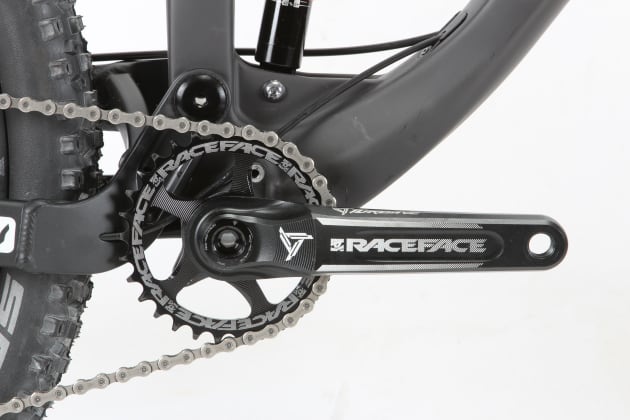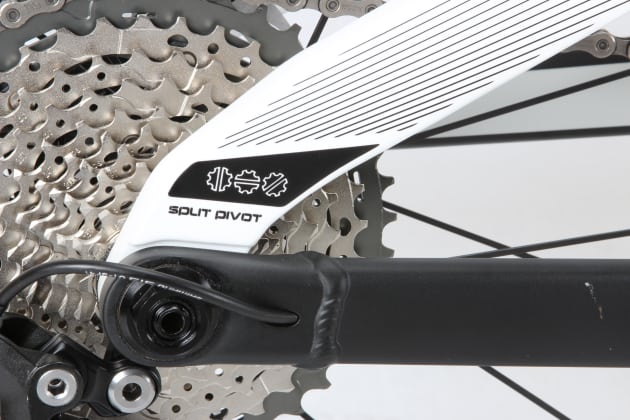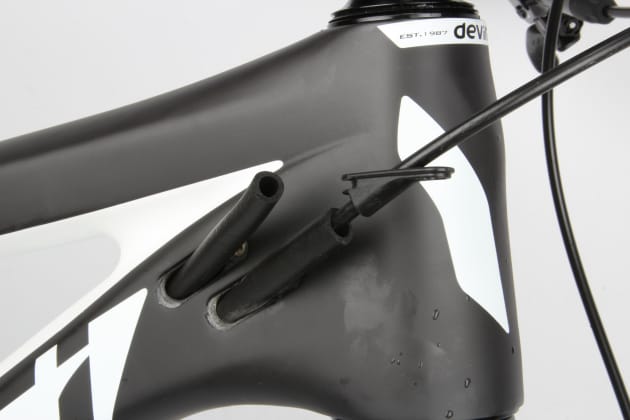Devinci Django
Devinci’s Django is both a very modern and very old take on mountain biking. It’s not a downhill bike and it’s not an XC bike; it’s simply a mountain bike and it’s designed to go wherever and however you want it to. It’s also perhaps a backlash against the tendency for riders to be ‘over-biked’ in recent years; just because you can get a super slack 160-170mm travel bike that pedals efficiently uphill and descends like a demon doesn’t automatically mean that it’s the best bike for most of us to ride most of the time.
With its 120mm of rear wheel travel paired to 130mm up front and a fairly moderate 67.5 to 68-degree head angle (the geometry is adjustable), it would be easy to pigeonhole the Django as a bit ‘vanilla’—conservative to the point of being uninspiring. Take a closer look however, and you’ll see it’s still sporting very short 425-427mm chainstays, a low bottom bracket and a substantial reach figure; very much on-trend with modern thought. So how does this mix of conservative and cutting edge play out in the real world? We’ve been putting the carbon-framed beast through its paces and it has been a whole bucket of fun!
First up, it’s worth mentioning that Devinci’s Australian importer specs their bikes differently to the Devinci global site, and there’s a fair degree of customisation available as a result. You can buy the Django as a frame only in carbon for $3,790 or $2,490 for the alloy version. Complete bikes start from $5,490 for an alloy Django with the same basic spec as our review bike—there’s no such thing as a low-end Django.

Our carbon test bike came with an excellent mix of parts including a Shimano XT 11-speed gears, Race Face Turbine cranks complete with direct mount Cinch 1X chainring and powerful XT brakes. Suspension-wise there’s a boost-spaced Pike RCT3 to complement the Monarch RT3 out the back. This is all wrapped up with a RockShox Reverb dropper post and 750mm Easton Haven carbon bars mated to a 55mm Haven stem. SRAM Rail 40 wheels round out a very well chosen mix of kit. As reviewed it’ll set you back$7,790 and it hit the scales at 12.66kg (set up tubeless but weighed without pedals). The large sized frame made up 2,960g of the total weight.
Steeze not Syrup
It’s a very muscular looking frame. Big box-section tubes, oversized pivot hardware and a massive bottom bracket junction all let you know that the Django is built to take a hammering; frame flex is non-existent. Love it or hate it, the wider 148mm ‘boost’ rear axle standard is here to stay, at least for a while. No doubt it contributes to both the stiffness of the back end and the compact dimensions of the chainstays, which are the only alloy part of the frame.
Devinci uses the Split-Pivot suspension system; it places the rearmost pivot concentric with the rear axle. It’s licensed from Dave Weagle and you’ll find it on all Devinci models. The Split-Pivot performs as claimed and does a good job of allowing the bike to pedal efficiently – energetically even – whilst still responding to the terrain when you’re on the brakes.

The Django’s geometry can be adjusted slightly by flipping the ‘nut’ at the seat stay/rocker pivot. This provides half a degree of head and seat angle adjustment and changes bottom bracket height by 6mm. I tested it exclusively in the low/slack setting but if you’re trails are more undulating than steep, you can tweak things a little for more responsive steering and better pedal clearance.
There are ISCG tabs if you want to fit a chain guide and whilst I’d personally prefer a threaded bottom bracket, the press-fit unit supplied remained quiet throughout our testing. Looking down at the bottom bracket and shock mount is a bit weird at first; Devinci has offset the shock to the left in order to make more room for the chainring and a chain guide if you choose to run one—seeing the shock off to one side does mess with your head a bit! What is always nice to see is room for a water bottle inside the frame, so you can ditch the hydration pack for those short blasts after work.
Cable routing is run through the downtube and after exiting just in front of the bottom bracket, the gear cable continues internally through the chainstay while the brake hose remains on the outside. There are two universal entry ports on either side near the head tube, so regardless of how you run your brakes and dropper lines, you’ll be able to set it up cleanly.
While there are no internal guides, rattles are minimised by using foam tubes that slip over the cables. The cable ports are on the small side however, which makes running new cables (especially the dropper post cable) a serious exercise in either patience or frustration, depending upon how you look at it. At least the Django carbon is 1X only, so you won’t need to bother with front derailleur routing. If you’re a 2X holdout, you’ll have to opt for an alloy frame instead.

Love it or hate it, the internal routing does leave the Django looking clean and tidy, which helps to emphasise the essentially straight, clean lines of the frame. Did I say it’s a good looking bike already? One friend compared it to a Stormtrooper, and I think that’s a pretty fair description of the starkly black and white colour scheme with angular shapes. Those clean lines also afford plenty of standover clearance so your delicate bits are well out of harm’s way if you need to dab a foot unexpectedly.
Unchaining Django
Before heading out you’ll need to set the sag on the fork and shock; the fork is pretty straightforward and I settled on about 20% with one volume reducing token. It took a little more tinkering to get the back end to feel right. Despite having a 57mm long shaft the Monarch shock only has a 44mm stroke, so you need to set it up paying careful attention to the etched sag markings rather than eyeballing the apparent overall travel—you’re never going to blow the travel indicator off the end of this shock.
I usually prefer my suspension set up on the softer side initially for terrain-hugging traction with a stronger ramp up toward the end. With this in mind I started with sag figures between 30-40%. However the Django has a pretty high leverage ratio and these settings led to too a lack of mid-stroke support. I should have realised that a mid-travel bike needs to run a bit firmer, and around 25% sag proved to be the sweet spot. It’s worth noting that the Django’s suspension is highly progressive, so even when running 40% sag it wasn’t eager to bottom out. When set at 25% sag I never quite hit the bump stop, even when I cased a drop onto an exposed root hard enough to put a 6-7mm tear through the rear tyre’s tread. It might be a bit short on travel but it always seems to have a bit left up its sleeve when you need it.
Descending on the Django is a fast and furious affair; the long front centre and progressive rear suspension encourages you to ride like there’s 40mm more travel and a head angle that’s a couple of degrees slacker. Most of the time this just makes it super fast and super fun, but it is certainly possible to get in over your head if you’re not careful; like Maverick, it’ll encourage you to overdraw your body’s cheque account. On moderately technical or tight downhills it’ll easily chase down a longer travel bike but if you try to hold on when the going gets rough, you’d better have some serious skills to back up the Django’s enthusiasm.

And here’s where the compromise of the long front centre and short rear end geometry reveals itself. If you aren’t riding fast on steep terrain, a conscious weight shift is required to keep the front tyre biting and prevent it from washing out mid turn. Old school geometry kept your weight fairly centred most of the time but meant you had to work hard to get your weight back when things got hairy. New school style makes it easier to have your weight centred when blasting downward through the chop at speed, but you have to work harder to keep traction up front by driving your weight through the fork on more gentle terrain. It’s a matter of horses for courses and you just need to be honest about how and where you ride in order to get the right setup for you.
The propensity for a light front end was exacerbated by the 140mm travel fork on our test bike. While Devinci are happy for you to run a 140mm up front instead of the standard 130mm, the longer you go the slacker the head angle gets, and this makes it harder to maintain front wheel traction. If you want a more descent-oriented bike Devinci has the 140mm Troy on offer and I think the Django would be at it’s best with the stock 130mm fork. Sure the longer travel fork increases outright stability on steeps, but a shorter fork will make it easier to keep the Django under control when things are less pucker inducing.
Get Up and Go
In terms of climbing performance, I think the Django is one of the best technical climbers I’ve ridden. The short chainstays more or less demand an out of the saddle style for attacking punchy and stepped climbs but reward you with excellent power transfer, traction and the ability to easily loft the front wheel over obstacles. The long front centre ensures you never feel cramped and if you’ve got the legs and the balance, there’s a very good chance the Django will summit just about any climb you can imagine. I also found that it performed best in these situations with the rear shock left wide open. It’s efficient enough to not wallow excessively under bursts of power, and keeping the suspension at its most supple gives you maximum traction in questionable conditions.

On long grinding climbs, running the shock in the middle position gave just a little more zip and zest to the Django. This also helped it from sagging too far into the travel and on smooth flow-trail riding it also gave a little more pop when hitting lips. Still, this is a bike whose suspension generally likes to be left unhindered. Once you come to realise that you can generally leave the shock alone and get on with the task at hand; and that’s driving the Django as hard as you possibly can into, through, around and over every trail feature and corner that you can find.
If you’re prepared to pilot it aggressively, the super stiff frame offers a great handling balance that encourages, in fact almost demands, you to push it into counter-steer and rear wheel drift through almost every corner. Throw it in and it’ll back you up, hold the line, and sling you out the other side ready for the next rapid directional shift. For 99% of us mountain biking is meant to be fun. The Django is one of those bikes that reminds you that this game we play is all about pleasure, not business—it just happens to get the business well and truly done at the same time.
Devinci has done a bang-up job in designing the Django as a very modern take on the old idea of a mountain bike. It’s one bike that you can ride anywhere, up or down, with a minimum of fuss and a maximum amount of grin. This isn’t the bike you take on a leisurely spin around the local green loop. It’s a ride that’ll have you seeking out challenging terrain and driving it hard and fast every time you swing a leg over. It’ll always give back as much as you put in, if not more, and if you like to ride hard it’s a deal well worth making.
Pros
Flat out fun, especially on technical trails
Great geometry for rowdy riding
Frame is as solid as a rock
Cons
Effort required to maintain front-end traction on flatter terrain
Confident handling can lead you in too deep on rough trails
Specifications
Frame Carbon with alloy chainstay
Shock RockShox Monarch Debonair 120mm Travel
Fork RockShox Pike, 140mm Travel
Headset FSA Orbit Sealed Bearing
Handlebars Easton Haven 35 Carbon 750mm
Stem Easton Haven 35, 50mm
Shifter Shimano XT
Rear Derailleur Shimano XT
Cassette Shimano XT 11-speed, 11-42
Chain Shimano XT
Cranks Shimano XT, 32T
Bottom Bracket Shimano
Pedals N/A
Brakes Shimano XT
Wheels SRAM Rail 40
Tyres Schwalbe Hans Dampf 2.35/2.25
Saddle WTB
Seatpost RockShox Reverb 31.6mm
Weight 12.66kg without pedals (medium frame 2,960g)
Available Sizes S, M, L and XL
Price $7,790 ($3,790 frame only)
Distributor Rowney Sports 1300 938 469 / www.rowneysports.com










